Jordan Wright
March 24, 2016
Special to DC Metro Theater Arts
Just as I was beginning a healthier diet what should appear in my mailbox but two wonderful books from Lifelong Books, both dedicated to vegan cooking. How psychic is that? Terry Hope Romero, who has written a number of cookbooks on the subject, and was voted “Favorite Cookbook Author” by VegNews in 2011, has come out with Protein Ninja: Power Through Your Day with 100 Hearty Plant-Based Recipes that Pack a Protein Punch. It’s especially geared to vegans who feel they might not be getting enough protein in their diet. I take that to apply to those of us who work out a lot as well as those who are strictly vegan. Now I do not purport to be vegan, or even vegetarian (I can’t/won’t give up eggs or seafood), but there are some fantastic recipes in these pages that can benefit all of us.
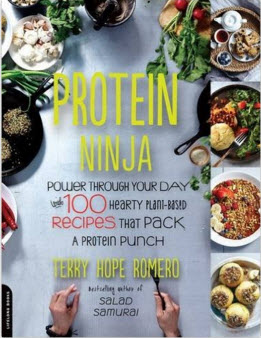
You may already be familiar with Romero’s books Vegan Eats World, Salad Samurai and Viva Vegan!, but she was also co-author of Veganomicon, Vegan Cupcakes Take Over the World, and Vegan Pie in the Sky to name a few. In her latest cookbook she gives us recipes for every meal of the day. Gratefully they are quick and easy, as well as ethnically diverse. No bored palates. The collection offers plant-based protein dishes that are more sophisticated and creative. One might easily say, gourmet.
Though Romero is vegan for ethical reasons of kindness to animals, there is much current evidence that this philosophy is leaning towards another scientific proof – that eating vegan is a solution to climate change. Think about it. The less impact on the environment, the healthier the planet. Okay, enough science. Pretty soon I’ll need footnotes. In any case, it’s fact-based. Trust me. Google it.
In her book Romero offers tons of advice on how to easily up your protein intake. She also tells you what dishes can be frozen, which is tremendously helpful to those of us on the go. And though many of these recipes call for a myriad of different ingredients, mostly staples, there is enough symbiosis between recipes that you won’t feel as though you’re wasting food or money. Also helpful is the recipe icon guide that lets you know which dishes are gluten-free, soy-free, etc.
It was nearly impossible to choose one recipe from all these tempting vegan burgers and patty recipes (there are seven and she calls them “Burger Bowls” since they consist of a full meal) or her “Bakery Basket” (that includes amped up biscuits, waffles and the like). Dressings make up another group of recipes and they are super-creative, like the Dill Pickle Thousand Island Cashew Dressing. But here is Romero’s recipe for White Bean Cashew Ricotta Toast that can be made savory or sweet.
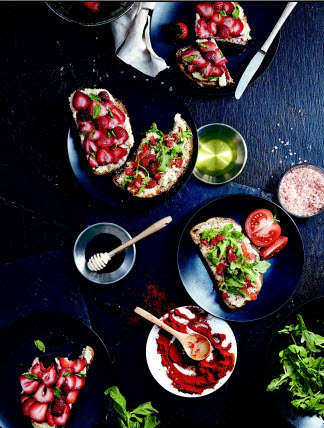
White Bean & Cashew Ricotta Toast
Makes about 2 cups spread in less than 30 minutes
I’m probably pushing the boundaries of what can be called a ricotta, but this satisfies my craving for a mellow, creamy spread without the usual help of tofu that plays well with fresh toppings, such as baby kale, arugula, and thinly sliced tomatoes or radishes or cucumber. Or go bold and use it as a base for sweet toast, too: sliced strawberries and chopped fresh mint, or a swirl of almond butter, chopped dates, and a dusting of cinnamon.
SPREAD
½ cup unroasted cashew pieces
1/2 cup hot tap water
1 (16-ounce) can cannellini beans or navy beans, well drained and rinsed
2 teaspoons mild flavored olive oil
2 teaspoons freshly squeezed lemon juice
1/2 teaspoon agave nectar
½ teaspoon salt
Hot whole-grain or sourdough toast
SAVORY GARNISHES
Baby kale leaves
Diced cherry tomatoes
Ground sweet paprika
Freshly ground black pepper
SWEET GARNISHES
Thinly sliced strawberries
Fresh mint leaves
Date syrup or pure maple syrup
Pink sea salt
- Make the spread: In a small bowl, combine the cashew pieces with hot water and soak for at least 20 minutes, or until the cashews are tender. Set aside 1 tablespoon of the soaking water and drain away the rest.
- In a food processor, blend the drained cashews and the reserved soaking water into a thick, slightly grainy paste. Add the beans, olive oil, lemon juice, agave nectar, and salt. Pulse into a thick mixture, occasionally stopping to scrape down the sides of the processor bowl. Don’t overblend; it’s preferable that this have a somewhat grainy texture. Taste and add a pinch more salt, sugar, or lemon juice, if desired.
- Use immediately, or chill for at least 30 minutes for the flavors to develop.
- Slather over hot toast and top with either the savory or sweet garnishes.
~~~~~
The path cookbook author Elina Fuhrman took to arrive at her passion has been a circuitous one to say the least. As a war correspondent and journalist for CNN, she’d fashioned a career writing about international conflict in far-flung hot spots. But nothing could have prepared her for the personal battle she faced when she was diagnosed with an aggressive form of breast cancer. In her search for health and wellness Fuhrman took on the challenge like the professional she is – researching, studying and interviewing doctors and nutritionists, from both Eastern and Western medicinal cultures. She calls her search her “healing pilgrimage”. The result is her debut cookbook. You might even call it a guide – Soupelina’s Soup Cleanse – Plant-Based Soups and Broths to Heal Your Body, Calm Your Mind and Transform Your Life. It has a little bit of schtick and a lot of tried and true recipes for the same freshly made soups she sells to her tony clientele in Los Angeles.

Fuhrman uses an artist’s palette of vegetables to inform her recipes – a nod to the “rainbow” concept of eating right. The first few dozen pages describe the application of Ayurvedic (from the Sanskrit “science of life”) principles to diet and lifestyle. She further delves into homeopathy, Chinese medicine and folk remedies, now commonly referred to as “alternative medicine”. Fuhrman makes a strong case for including these ancient theories and practices into her holistic regimen and offers 3- and 5-day detox cleanses, extreme for some, yet useful for those seeking a dramatic kickstart to their diet.
From quirkily named soups like “Easy Peas-y”, “Don’t Kvass Me Any More Questions”, a title derived from her Russian roots, and a cold soup called “Brave New Watermelon” that incorporates watermelon rinds (who knew?), it’s a book to teach as well as inspire. I particularly liked reading the prefaces to each recipe. They describe why it’s good for you, what symptoms it addresses, and what nutritional benefits it contains.
Here’s a recipe from the book that uses a delicious springtime ingredient – watercress. Though it calls for a Vitamix, you can just as easily use a blender.
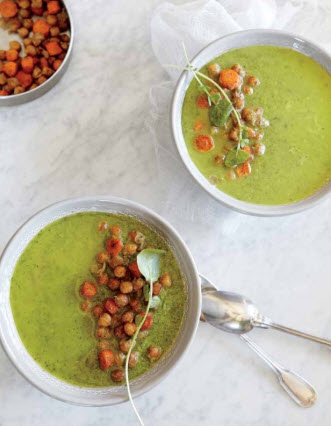
GONE WITH THE WATERCRESS
I’ve been looking to bring watercress into my diet for a while, but for some reason, I shied away from its bitter, peppery flavor. Until I read studies that it has significant levels of glucosinolate compounds, which means major anticancer benefits. Having these compounds in your body appears to help inhibit breast, lung, colon, and prostate cancers. When I remembered the delicious roasted chickpeas and carrots dish I had in Capetown, spiced with the intense North African blend called ras el hanout, I decided to play with the flavors. The sweetness of chickpeas totally worked with the bitterness of watercress, and the flavors seriously transported me to another continent. Not to mention the soup’s health benefits: It’s an antidote to fatigue, and great for detoxifying your body, healing your respiratory and digestive systems, and protecting against free radicals.
Serves 4
+ Preheat the oven to 350°F.
+ Combine the carrots and cooked chickpeas with the ras el hanout and a sprinkle of olive oil, and arrange on a baking sheet lined with parchment paper. Roast for 15 to 20 minutes, until al dente. Reserve half of the spiced chickpeas and set aside.
+ Meanwhile, heat the oil in a soup pot over medium heat, add the onion and ginger, and sauté until the onion is translucent. Add the nonreserved spiced chickpeas, watercress, salt, and boiling filtered water and simmer until the leaves wilt, about 3 minutes.
+ Transfer the mixture to a Vitamix and blend until smooth.
+ Taste and add salt to your liking.
+ Serve with the hot spiced carrots and reserved chickpeas.
- 3 carrots, diced into ¾-inch pieces
- 2 cups cooked chickpeas
- 2 tablespoons ras el hanout
- 2 tablespoons extra-virgin olive oil
- 1 onion, chopped
- 1 (1-inch) knob fresh ginger, grated
- 1½ to 2 bunches watercress
- Himalayan pink salt
- 3 cups boiling filtered water
Jordan Wright
July 15, 2015
Special to Indian Country Today Media Network
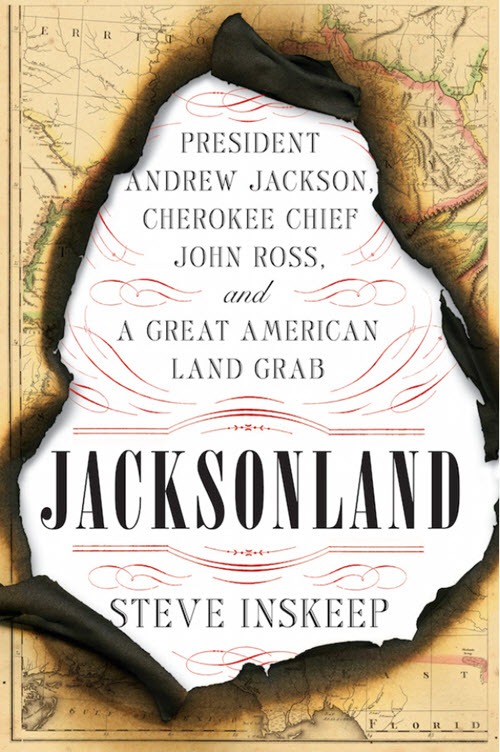 Morning Edition co-host Steve Inskeep’s book Jacksonland: President Andrew Jackson, Cherokee Chief John Ross, and a Great American Land Grab tells the almost-lost-to-history story of Cherokee Chief John Ross and his attempts to save the Cherokee Nation from President Andrew Jackson. Photo credit: Penguin Press You don’t need to be a history buff to dive headlong into Jacksonland: President Andrew Jackson, Cherokee Chief John Ross, and a Great American Land Grab (Penguin Press, 2015), Steve Inskeep’s riveting masterpiece of two influential men who held radically opposing visions for our country. The well-respected author and co-host of National Public Radio’s Morning Edition recounts in vivid detail the ultimate story of power, ego and greed that was played out in the Deep South (which Inskeep dubs Jacksonland) and which ultimately defined the future settlement of our nascent nation. Coming from relatively humble roots, both men once fought on the same side and later crossed verbal swords in defense of their principles—Jackson, whose desire for personal gain for both himself and his well-heeled cronies translated into immense power and control of the Union, and John Ross, a well-educated and savvy Cherokee Indian chief committed to protecting Indian territories and sovereign rights.
Inskeep toggles between chapters about Jackson and Ross as he methodically lays out their personal journeys, meticulously detailing their early lives, crossed paths, and the events and battles that lead to the ultimate betrayal—the Trail of Tears. But the events do not progress in a straight line. And that’s precisely what makes this a page-turner.
At stake in 1812 were the territories of the Five Civilized Tribes—Cherokee, Seminole, Chickasaw, Choctaw and Creek—whose collective territory extended from the southernmost tip of Florida, around the panhandle to Louisiana and the Gulf of Mexico to the south, westward along the muddy banks of the Mississippi River to the Missouri Territory, and north in a winding border that extended from the Atlantic Coast south of what is known today as Georgia and along the northern reaches of the Tennessee River. This was the so-called Indian Map. On the contrary, the “White Man’s Map” of the same period laid claim to everything east of the Ohio River and the Mississippi, with the exception of Florida, which was still in Spanish hands.
Known to his people by his Cherokee name, Kooweskoowe, Ross was able to access the “whiteside,” as he called it, using his mixed Scottish and Indian ancestry to straddle both Indian and white political and social spheres. Trained as a lawyer, he sported the sartorial style of white politicians, cutting an imposing figure as he strode through the halls of Congress, negotiating with lawmakers to strike deals favorable to his people. There was no more dedicated and effective representative for the Cherokee, and they trusted and relied on his savvy statesmanship.
But the dark side to this era of Indian relationships with the U. S. government is the backstory of Jackson’s unimaginable greed, ruthless double-dealing and consolidation of power. How he granted favors to and colluded with his associates to obtain land for their personal enrichment, while breaking promises to the Indian nations.
Through personal letters written by Ross and Jackson, and a wealth of documents of the period, Inskeep has achieved an exhilarating read. Outlining the real history of Jackson’s rise to the U.S. presidency, and Ross’s hard-fought efforts for the Cherokee, the author makes it clear that given a few different conditions, the removal of the tribes might never have happened. For example it is stunning to learn that the 1835 Treaty of New Echota, in which the Indians ceded territory and agreed to move west, prevailed by a single vote, even though it had never been signed by Chief Ross or the Cherokee National Council. And that Jackson’s biggest battle may have been his health, which was so poor that frequently he was perilously close to death.
As a seasoned reporter, Inskeep has said he was driven by “the disgraceful politics of the past few years” to write this book. That passion has driven him to give us a clear-eyed and fascinating story of two influential men, one whose democratic values followed the principle of majority rule, and another who represented minority rights. But he has also delivered a cautionary tale of the machinations of the rich and powerful that especially resonates today.
Read more at http://indiancountrytodaymedianetwork.com/2015/07/15/jacksonland-riveting-narrative-details-chief-john-rosss-attempts-save-cherokee-nation
JORDAN WRIGHT
July 15, 2015
Special to Indian Country Today Media Network
 Author Steve Inskeep, co-host of NPR’s Morning Edition, discusses ‘Jacksonland: President Andrew Jackson, Cherokee Chief John Ross, and a Great American Land Grab,’ published by Penguin Press. Photo credit: Linda Fittante Noted author and journalist Steve Inskeep, co-host of Morning Edition on National Public Radio, sat down with Indian Country Today Media Network to dissect his new book, Jacksonland: President Andrew Jackson, Cherokee Chief John Ross, and a Great American Land Grab, published this summer by Penguin Press. The book, a riveting masterpiece about two influential men who held radically opposing visions for Turtle Island, brings to light lesser-known facts about this time period that the publisher calls a “crossroads of American history.”
What prompted you to write this story?
I just wanted to tell the whole story, and it was interesting to me to realize how little of the story I knew. John Ross was almost an entirely undiscovered character, an interesting character, and I wanted to find out what made him tick.
What was your reaction when you began to discover a clear picture of interwoven greed and power?
It wasn’t a complete surprise. How it worked, and why, was new to me. It’s understood that there were national security motives and patriotic motives to clear Indians out of the Southeast. But I don’t think it’s as well understood that there were also economic motives and a desire for land and a desire to expand slavery that was behind it and that really drove it. And that Andrew Jackson himself was personally involved in developing the land that he obtained as general. I came across a lot of detail that had never been put together in quite this way.
There were so many moments when things could have gone in an entirely different direction, as when the Indian Removal Act won passage in Congress by only one vote. It seems the press was hugely influential then, creating stories out of whole cloth while spreading fear and innuendo about the Indians. Do you think newspapers were more influential then than they are today?
Newspapers then were more influential because they were the principal form of media. There would have been around three dozen newspapers during late colonial times. By the early 1800s they were in the low hundreds, then very quickly it goes up to around 800 by 1828. Everybody read each other’s papers, and people would send them around by mail.
Do you think Sequoyah’s creating of the Cherokee syllabary in 1821, and its usage in Ross’s newspaper, helped spread the word?
Yes and no. The Cherokee Phoenix newspaper had articles in both Cherokee and English. And so, although it was a cultural triumph to have their own written language in a newspaper, it also had propaganda value. But the real political punch was that editors of other papers would read the Cherokee perspective of events that were different from the White perspective of the same events.
RELATED: Book Strips Away the Myth Surrounding the Cherokee Syllabary
How important do you think Ross’s ability to walk on the “whiteside,” as it was called then, contributed to his success as a diplomatic envoy?
I think it was very important that he was able to speak English and present himself in a way that white men could understand and relate to, and that sometimes he could also pass as a white man. I’m not saying that was good or bad. It was just the political reality of the time. That could also be used to undermine him, though. And it was also used to challenge him. Cherokees didn’t challenge his status as an Indian, but whites would undermine his racial credentials and say he wasn’t Indian enough. So sometimes it was a double-edged sword.
The most important thing was that he was literate in English, could write his own letters and make his own demands, and was not dependent on an interpreter to get across all the nuances of what was intended in agreements. Others who signed treaties may not have known what they were signing. Ross understood the terms and the wider political context of what the Indians were being offered.
What do you think was Ross’s greatest success?
I think it was when he blocked Jackson from grabbing two million acres of land, even though later Jackson went around him. At the end I don’t think it’s widely understood that before the Trail of Tears, Ross improved the terms under which the Trail was to be undertaken. He managed to keep the Cherokees together and get more than $6 million for the land. Though that was not what it was worth, it was substantially more than what the government was offering. At the same time Ross managed to keep the Cherokee government together. All along he was innovative in the use of democratic tools in a way that adds to our democratic tradition and foreshadows a lot of things that civil rights leaders did a century or more later.
In the end, if the tribes had held together and not sold their lands, do you think there would have been a larger war?
We have an answer to that. More or less, yes! We saw it happen in Florida. There was a war that lasted for years. Thousands died, U.S. soldiers, civilians and Seminoles. We’re talking about a really awful conflict for its time, and that, I suppose, would have been the alternative. In Alabama there were Creeks who did not want to go away, and there was an insurgency there in the 1830s. You could have had more devastating wars. There can’t be any doubt about what the result probably would have been, because even if they were all united, they were so outnumbered by then. Had they united in some effective way, you could have had a different course of history. But they didn’t, and when there was an attempt to unite them under Tecumseh, it didn’t turn out very well for the Indian side in the end.
During your extensive research, what surprised you most?
I had no idea that the Cherokees had done so much in their own defense. I think that has been overlooked, even by accounts that were sympathetic to the Indian side. I think Indian removal has often been portrayed as an argument among white people, though there were people who were for it and people who were against it. I’m not sure that the Cherokee participation in the emerging democratic life in the United States has been recognized in the way that it should be.
What would you say are the parallels to today’s struggle for civil rights?
I think some of the same techniques John Ross used were those used by civil rights leaders in the 20th century. Cherokees decided they needed their own newspapers, as did African Americans. They also both realized they needed white allies, and both groups reached out to the religious communities to get some of those allies.
Both groups fought in Congress, and both fought and won before the Supreme Court. In the end though, the Cherokee efforts and victories did not do them a lot of good. While by no means perfect, by the 20th century, racial attitudes were changing and improving, and it was becoming less and less acceptable to argue that there were entire racial groups of people not entitled to become full citizens of the United States.
In the recent campaign to put a female icon’s image on American paper currency, would you prefer to see Jackson removed, rather than Hamilton?
I wrote an article for The New York Times recently in which I proposed that John Ross should be on the twenty-dollar bill and Andrew Jackson should be on the flip side. I think there should be two characters on every bill. Each pairing should be people who relate, so that they tell a story about our democracy and about imperfect people fighting it out about our democracy. Abraham Lincoln could be paired with Frederick Douglas. Ulysses S. Grant on the $50 bill paired with Harriet Beecher Stowe. It would give a greater sense of this grand democratic story that we are all a part of, and the way that different kinds of people participate in that story and have influenced it over time. Jackson and Ross were not perfect people. They were people who fought within the democratic system.
Read more at http://indiancountrytodaymedianetwork.com/2015/07/15/author-steve-inskeep-talks-john-ross-andrew-jackson-and-trail-tears-161079
Jordan Wright
April 7, 2015
Special to DC Metro Theater Arts
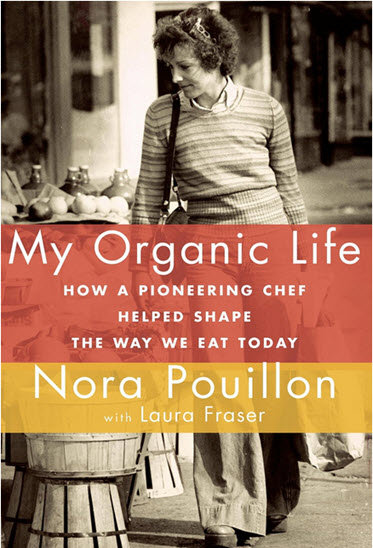
A small farm high up in the Tyrolean mountains gave Nora Poullion her first taste of organic foods. While their father tended to his business in Vienna during World War II, Nora, her mother and two older sisters were safely ensconced in a rudimentary chalet where they lived with a farmer and his wife who baked bread from their own wheat, grew their own vegetables, milked the cows for butter and cheese, and gathered mushrooms from the forest. They were joined there by two old family friends – – Jewish refugees fleeing from the Nazis. These were the experiences that informed the direction of her life.
In her poignant memoir Poullion allows us into her private world before she was recognized as an American culinary pioneer through her commitment to local, sustainable and organic food. The book takes us along on her journeys throughout Europe and later in the U.S. at a time that parallels the rise of the organic Food Movement. When food was becoming ever more distant and chefs were buying from huge wholesale suppliers, Nora began to cultivate relationships with local farmers – – something I learned firsthand when I interviewed her seven years ago at the Dupont Circle Farmers Market where she still shops each week for Restaurant Nora, the first certified organic restaurant in the United States.
A few weeks ago we reconnected for the launch of her new book, My Organic Life: How a Pioneering Chef Helped Shape the Way We Eat Today (Alfred A. Knopf – April 2015) written with Laura Fraser. As in her book Poullion spoke candidly over lunch about her early experiences in America. “I was astonished when I came to this country. Everything was packaged in plastic and there was no culture around food. Back then Pepperidge Farm was the gourmet bread!” You can well imagine how far removed this was to someone whose upbringing reflected the care and attention given to food in Europe. Remembering her first impressions she added, “I noticed how unhealthy people were. They just went to the doctor to get a pill!”
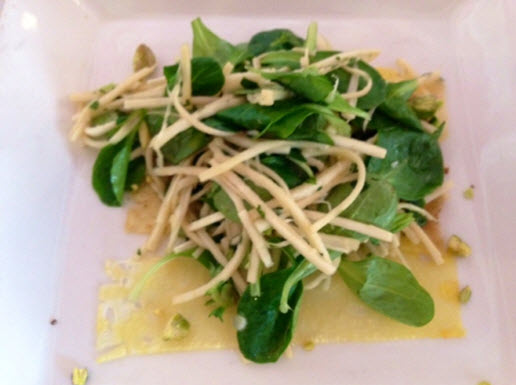 Hearts of Palm Salad with pineapple carpaccio, mâche, pistachios and yuzu vinaigrette In the book Poullion recalls her arrival in Washington, DC in 1965 with her journalist husband, Pierre. As a young woman and newlywed she didn’t know how to cook. So charged with hosting his many ex-pat friends who excelled at cooking and entertaining, she turned to James Beard’s cookbooks for inspiration. By 1972 she had achieved such a stellar reputation for her French cooking and catering, that she began giving cooking classes. “Ralph Nader was my first student,” she recalled.
Area residents who have followed her career will remember her first restaurant inside the Tabard Inn, a small B&B in Dupont Circle. “I was stunned when twenty people came in!” she said of her first lunch service. One year later, after a stint flipping burgers in a local joint (No one can say she hasn’t paid her dues!), she and partner, Steven Damato, and his brother, Tom, opened Restaurant Nora. Later the trio enjoyed an eight-year run with City Café before turning it into the since shuttered Asia Nora.
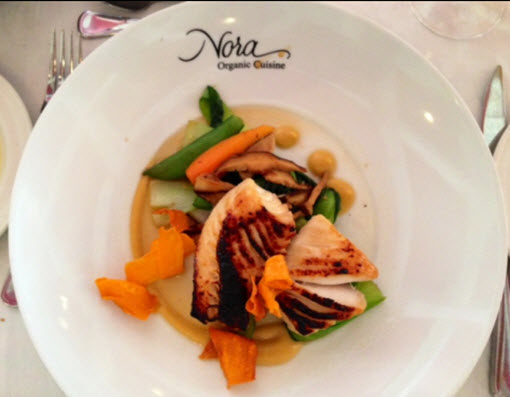 Sake Glazed Black Codwith ginger miso emulsion, bok choy, shiitakes, snow peas and crispy yams On this sunny afternoon she was seated beside her close friend of many years, Diane Rehm, the beloved NPR broadcaster. Rehm is one of the many notables – – from Jimmy Carter to the Obamas – – who have regularly patronized the restaurant.
Before our delicious lunch came to a close I begged (Yes, I really did beg!) for the recipe for the scrumptious dessert she served. It was a fabulous cake she planned to bake for Jacques Pepin’s upcoming 80th birthday tribute. Behold I give you Nora’s grandmother’s recipe for Austrian Chocolate Almond Cake. What I won’t do for my dear readers…
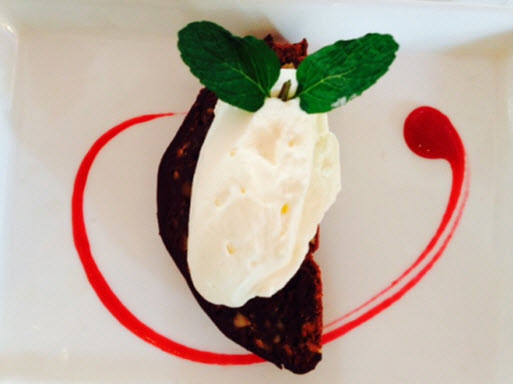 Austrian Chocolate Almond Cake AUSTRIAN CHOCOLATE ALMOND CAKE WITH LIGHT WHIPPED CREAM
- 1 ½ cups almonds
- 4 ounces unsalted butter
- 4 ounces semi-sweet chocolate
- ¾ cup sugar
- 6 egg yolks
- ¾ cub breadcrumbs
- 6 egg whites
- Preheat the oven to 325 degrees Fahrenheit.
- Spread the almonds onto a baking sheet and bake for 8-10 minutes, until fragrant and toasted. Let the nuts cool. Coarsely chop the almonds.
- Butter an 8-inch spring-form pan with one teaspoon of butter and dust with some of the breadcrumbs.
- Melt the chocolate in a double boiler over simmering water. Remove from the heat and allow to cool slightly.
- Combine the butter, sugar, and cooled, melted chocolate in the bowl of a mixer and beat until the batter changes to a lighter color and becomes creamy, about three minutes. Scrape down the sides of the bowl once or twice while beating.
- Add the yolks, one at a time, and continue beating. Lower the speed of the mixer and add the ground almonds and breadcrumbs.
- Beat egg whites* (see tips below) until soft but not stiff. Stir a third of the beaten whites into the batter, blending thoroughly. Gently fold in remaining whites, working quickly and carefully to incorporate all the whites without deflating the batter.
- Pour the batter into the prepared pan and smooth the top. Bake 50 – 55 minutes or until a toothpick inserted in the center comes out clean. The center of the cake can still be soft.
- Allow the cake to cool in the pan for 10 minutes before turning it out onto a cake rack. Let the cake cool completely before adding the glaze. Serves 12.
CHOCOLATE GLAZE
For one 8-inch cake
- 3 ounces semi-sweet chocolate
- 3 ounces unsalted butter, softened
- 1 ounce of room temperature milk chocolate for garnish
- Melt semi-sweet chocolate in a double boiler over simmering water. Add the butter and stir until blended and smooth. Remove the glaze from the heat and allow it to cool and thicken to the consistency of thick cream.
- Brush the cake to remove any loose crumbs, and place both the cake and the cooling rack on a sheet pan to catch the chocolate glaze. Slowly pour a pool of chocolate glaze onto the center of the cake. Working from the center out, use a long metal spatula to spread the glaze evenly over the top and sides of the cake.
- For a smoother look, you can glaze the cake a second time. Scoop the excess glaze from the sheet pan and reheat it in a small double boiler. Pour it through a sieve, if necessary to remove any cake crumbs, and cool it slightly to thicken a bit. Pour the glaze again onto the center of the cake and allow it to spread without using a spatula.
- With a vegetable peeler, shave off some curls of the milk chocolate and sprinkle them on top of the cake. Allow the glaze to set for 2 hours at room temperature or at least 20 minutes in the refrigerator.
LIGHT WHIPPED CREAM
- 4 tablespoons heavy cream
- 1 egg white
- 1 tablespoon superfine or confectioners’ sugar
- Fresh mint for garnish
- Whip the egg white until it holds its shape. Whip the cream in a separate bowl until it forms soft peaks, then add the sugar. Continue to whip the cream until it forms soft peaks again. Fold the egg whites into the cream.
- Assembly: Cut 4 pieces of the cake and put one piece on each of four dessert plates, garnish with a dollop of the light whipped cream and a sprig of mint.
Nora’s commentary
This is my grandmother’s recipe for a traditional Austrian cake, called Rehrueken. The name means “venison saddle” because the cake is usually baked in a long, half-roll pan to imitate a saddle of venison.
No matter what you do, this cake never fails. Under-baked, it tastes like a brownie. The original Viennese recipe uses almonds, but sometimes I make an Italian version, substituting pine nuts and serving it with an Amaretto cream or ice cream. I have made an American version using pecans and a bourbon whipped cream or ice cream.
The simple glaze always works, and my customers and family love it. Our neighbor in Vienna, the daughter of a famous restaurant owner, gave me this glaze recipe.
You can flavor the whipped cream with any kind of liqueur or with a few drops of pure vanilla, honey, rosewater or a pinch of cinnamon.
*Nora’s Tips
It is important not to over-beat the egg whites. Whip them just until they keep their shape. If over-beaten, they are difficult to fold in thoroughly and over-beaten eggs can cause the cake to rise too high, crack, and fall as it cools.
Jordan Wright
April 4, 2015
Special to DC Metro Theater Arts
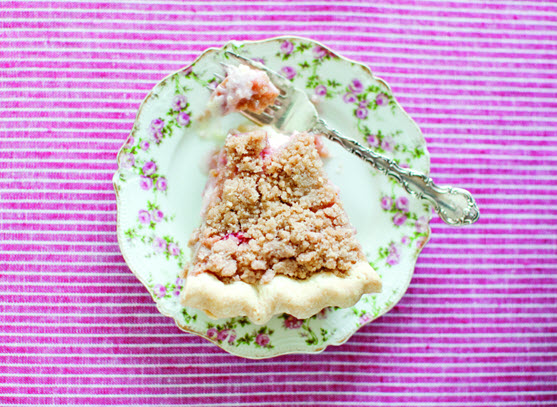 Sour Cream Rhubarb Pie from Butter Baked Goods As the owner of the pink-and-pistachio colored bespoke bakery Butter Baked Goods in Vancouver, Canada, Rosie Daykin is realizing her dream. After ditching a successful career as an interior designer, Rosie returned to her lifelong passion turning her pretty cabbage rose-wallpapered bakery café into a worldwide business enterprise. In her first cookbook, Butter Baked Goods – Nostalgic Recipes from a Neighborhood Bakery (Alfred A. Knopf 2015), Rosie shares secrets of some of her most irresistible delicacies dividing chapters into breakfast indulgences, pies, classic cakes, muffins, cookies, bars, brownies and cupcakes. There are recipes for butter creams and frostings, and even her coveted recipe for Butter’s famous gourmet marshmallows found at over 300 retailers across North America.
What I loved about this book is Janis Nicolay’s soft focus photographs of dozens of Rosie’s simple homemade desserts like Sticks and Stones Cookies, Chocolate Nutella High-Top Cupcakes, Bumbleberry Pie and Butterscotch Maple Pecan Scones.
Just in time for spring, we’ve giving you her recipe for Sour Cream Rhubarb Pie. Happy baking!
As Rosie describes it, “This recipe came to me from my dear friend Margie. We became fast friends the day our family moved onto the block. You couldn’t ask for a better neighbor, and when I found out she was a keen baker I knew she was one for keeps! I think this may be my all-time favorite pie. The combination of sour cream, rhubarb and crumb topping is so good, it should be illegal.”
SOUR CREAM RHUBARB PIE
- Preheat the oven to 400°F.
- In a large bowl, combine the sugar, flour and salt. In a separate bowl, whisk together the eggs, sour cream and vanilla, then add to the flour mixture.
- Place the rhubarb in the prepared pie shell. Pour the egg and flour mixture evenly over the top.
- Bake in the preheated oven for 10 minutes. Lower the oven temperature to 350°F and bake for 30 minutes more.
- Meanwhile, in a small bowl, combine the ingredients for the crumb topping and mix with a fork until crumbly.
- Remove the pie from the oven and sprinkle the crumb topping over the top. Return to the oven to bake for another 15 minutes or until the topping is lightly browned.
- Remove from the oven again and allow the pie to cool slightly before slicing.
Ingredients
- 1 Butter’s All Butter Pastry single crust pie (page 192)
- 1 1⁄4 cups sugar
- 3 tablespoons all-purpose flour
- 1⁄2 teaspoon salt
- 2 large eggs
- 1 cup sour cream
- 1 teaspoon pure vanilla
- 3 cups rhubarb (fresh or frozen), cut into 1⁄2-inch pieces
Crumb Topping
- 1⁄3 cup sugar
- 1⁄3 cup all-purpose flour
- 1⁄4 teaspoon salt
- 1 teaspoon cinnamon
- 1⁄4 cup butter, softened
MAKES: 1 pie, about 8 to 10 slices
YOU WILL NEED: (9-inch) pie dish
“Margie has frozen this baked pie. She tells me that once it is defrosted and warmed slightly in a 200°F oven, you would never know it had ever been frozen.”
Jordan Wright
December 6, 2014
Special to DC Metro Theater Arts
 Elisabeth de Kergorlay Elisabeth de Kergolay has led a charmed life with nannies, chateaus and pied-a-terres, though that’s never stopped the beautiful young countess from using her entrepreneurial spirit to bring fresh ideas to America. Take for example her early investment in Le Pain Quotidien, the rustic chic French bakery café she invested in with Belgian chef and founder Alain Coumont in 1990. Since then the well-known communal table eatery with four locations in the DC area, has skyrocketed to 200 outlets in 17 countries. She clearly knows a great idea when she sees it.
Recently de Kergolay launched a frozen food emporium in New York City that is poised to recreate the same success she has enjoyed through her earlier business foray. Fashioned after the popular Paris store Picard, Babeth’s Feast opened on the Upper East Side in early August. The groundbreaking store offers high-end frozen foods and cooking demonstrations. Where has this clever idea been?
After learning about her venture at the opening of Daniel Boulud’s new DC outpost DBGB, Whisk and Quill was highly intrigued to learn more about this novel concept.
Jordan Wright – What is your past experience with food?
Elisabeth de Kergolay – I grew up around food, and being around Daniel when I was young was a great experience.
Tell me about your inspiration for Babeth’s Feast? How long has it been in the planning stages?
It was based on the concept of Picard from France. Arriving in New York in 2008, I like many other French people wondered, ‘Where’s the frozen food store? Where’s the Picard?’ When I realized there wasn’t one, I thought it had been tried and failed. But actually it had never been tried! So I thought about it a lot and spoke to quite a few people and decided to go ahead. I knew there was a niche for this, though it took several years to achieve. We had to do absolutely everything from the ground up – – creating and positioning the brand, selecting the products and designing the packaging.
The idea was to have a full range of products. We like to think of ourselves as a frozen grocery store where you can get anything you want for every meal of day. We have 400 products divided up into 10 different food categories. For sourcing and creating the recipes we have our chef, Susie Cover, who develops the recipes. Initially we made a list of what we liked of French-inspired foods then adapted them slightly to suit American tastes. We make over half of our products. Some are made by Susie, and some by private label, others are manufacturers’ brands made by companies who are specialists in their field. Of course we want our own products to be predominant in the future, but for the moment the remaining products are manufacturers’ brands. For that we select small companies who are specialists in their field.
Has Daniel been involved with Babeth’s Feast?
Daniel wrote a recipe for our cabbage soup using our fantastic lobster tails – – something new we had brought in for the holidays. We work with a lobster manufacturer in Maine to assure the most impeccable quality. In the future I want to explore having other chefs create dishes for us.
Are all the foods prepared?
Mostly, but some are unprepared cuts of meat and sausage and things that we source locally from the Hudson Valley. Also all our fish are raised sustainably. For uncooked products we help the customer with recipes.
Who creates the recipes?
Susie does. We brainstorm together to come up with different dishes and then she comes up with a recipe. Most of the original ones we did were traditional French, but we have moved on to curries and other things. We taste new dishes with our store team and our board to decide which we like. For the best local products, Susie also visits the food shows. For example, our ice creams are from Maine and New York, our meat-based products are prepared in Connecticut, and we produce our soups and quiches in New York.
Are they made in the sous vide style?
Ours are flash frozen, but some of the products we carry are made sous vide.
How are they readied for the table by the consumer?
Usually we have three options – bake, microwave or pan-warmed as with our velouté soups. Of course if it’s a gratin, it needs to be baked.
Do you sell any fruits, herbs, lemons or salad fixings to complement the dishes?
We have a selection of frozen herbs that have been very successful from the day we opened, like chopped onion, garlic and shallot, as well as sauces and spreads. And we have a pantry category as well. We carry crackers for the spreads, jams for our breads and sauces for our meats. Some of the jams are ours and some are French brands that are not yet known in the US.

Do you find customers buy your products to take to their weekend homes for entertaining?
Absolutely. I think the customer has yet to get used to the idea of having things in advance for special occasions as well as for regular use for whenever you need them. For me, although I still like cooking, perhaps I won’t make a side dish. I might make some fish or meat that I’ve purchased elsewhere to complement some of the side dishes that I keep in my freezer. It’s a whole way of mastering the use of frozen food. It answers many needs.
Do you ship to customers who might not have access to high quality foods?
We ship nationwide by FedEx. It’s packed in dry ice. And we deliver around Manhattan too.
What are the most popular items?
So far mostly the main courses like Coq au Vin, Veal Blanquette, Chicken Provençal and Chicken Tarragon. Also side dishes like Susie’s gratins and her favorite savory crumbles. She’s made three this season – one with Brussels Sprouts, one using tomatoes and another with butternut squash.
| Coq au Vin |
Fig and Caramelized Onion Puffs |
Tomato Crumble |
 |
 |
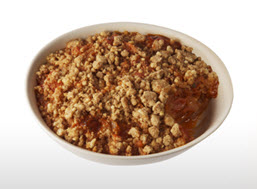 |
What surprised you the most since you’ve opened?
I think really the time and the interest that people spend in the store looking before buying. When I shopped at Picard in France I was single and going out all the time, I didn’t spend a lot of time looking.
People are learning that we have a tasting area where we sample all day long. It was something that was indispensable to the success of the store. Because when they try they “get it”, and it’s so satisfactory for us. We know there’s a certain stigma attached to frozen food because the offerings haven’t been great. In France people choose to go to the frozen food store. It’s not considered a last resort.
I looked at your online calendar and your upcoming cooking demonstrations sounded exciting. I was especially captivated by the one called “Comfort Food” featuring Cauliflower Blue Cheese Velouté, Lamb Shanks, Sweet Potato Écrassé, and the Banana Apple Crumble. Are you also teaching your clients to cook at home as well as purchasing the products?
We show them how to pull it all together. When we give a demonstration we’ll use a few different products to create a meal. We want to keep it simple. We also show people how to plate the foods and show them tricks as how to serve it in their own dishes.
What other helpful tricks do you use?
We use a color code for each category of product. The idea behind this was to see exactly what the product is when it’s in the freezer. Like the breakfast products are coded yellow. That way you can see immediately what you have without having to rummage around.
Babeth’s Feast is at 1422 Third Avenue, New York, NY 10028. For more information visit www.BabethsFeast.com
 Mini parfaits
|
















